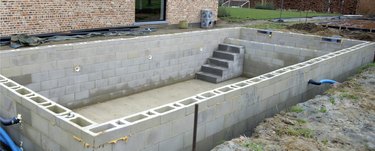
Things You'll Need
Dust mask
Protective goggles
Solvent resistant gloves
Solvent resistant scrub brush
3 buckets
Ammonia
Muriatic acid
3 sponges
The white alkaline substance that often crops up on cinder block walls is called efflorescence. This unsightly stuff is easy to get rid of with a little cleaning. However, you must find the source of the water and eliminate it or the efflorescence will crop up again.
Step 1: Prepare a Soap Solution
Mix a soap solution of 1 tbsp. liquid detergent soap per gallon of water.
Video of the Day
Step 2: Dry Brush the Deposits Off
Brush the bulk of the deposits off of the surface of the wall with a dry brush. If the white stuff flakes off, the deposits are on the surface of the wall. If the white stuff doesn't budge, the efflorescence came through the interior of the brick and it's behind the sealant. In this case, move on to Step 5.
Step 3: Scrub the White Alkaline Substance With Soap
Dip the scrub brush in the soap solution and scrub the white areas. Rinse frequently. Keep scrubbing until you make no more progress. Then rinse the wall clean.
Wear a dust mask when using acid and scrubbing efflorescence.
Step 4: Dry and Inspect
Allow the cinder block wall to air dry and inspect it. The soap and water may be enough to remove the efflorescence. If some is left behind, scrub again. If that still does not remove the white stuff, there may also be efflorescence underneath the sealant. Move on to Step 5.
Step 5: Wet the Area
Wet the white portions of the wall (and roughly one foot beyond) thoroughly.
Step 6: Mix the Muriatic Acid
Mix the muriatic acid with water in a plastic bucket according to the container's instructions (usually 5 parts acid to 100 parts water). Always pour acid into water, never water into acid.
Wear long clothing, protective gear, hair covering and closed toe shoes when handling muriatic acid. It is one of the most dangerous chemicals available to the home do-it-yourselfer.
Step 7: Create an Ammonia Solution
Mix 1 part ammonia and 1 part water in a separate bucket. Keep it on hand near the treatment area.
Step 8: Apply the Solution to the Walls
Apply the solution to the cinder block wall with a rag. Avoid drips as much as possible. Keep a bucket of clean water and a sponge nearby and clean any spills immediately. Scrub the walls with a scrub brush. Scrub slowly and carefully to prevent the solution from flicking off the walls and onto you or the floor.
Step 9: Let it Sit
Leave the muriatic acid solution in place for five minutes.
Step 10: Neutralize the Acid
Rinse the cinder block wall with the ammonia solution to neutralize the acid. Use as little solution as possible to avoid drips. Use a dedicated sponge for the ammonia wipe. Don't transfer the acid sponge to the ammonia.
Step 11: Rinse the Cinder Block Wall
Rinse the wall with clean water and a sponge. Use as little water as possible to avoid drips. Rinse the sponge frequently as you wipe the wall down. Rinse a second time to make sure all of the acid is gone.
Step 12: Finish Removing the White Alkaline on the Cinder Block Walls
Allow the cinder block wall to air dry, then observe the wall. If there are still white deposits left on the wall, repeat Steps 8 through 11 until they are gone. Rinse three times after the final application to make sure all of the muriatic acid is gone. Any residual acid can slowly erode the cinder block.
Tip
Efflorescence has two primary causes. Water on the surface of the bricks may leave mineral deposits behind as it evaporates. Or, water on the other side of the wall may move through the cinder blocks and deposit minerals from inside the cinder blocks onto the surface.
Video of the Day